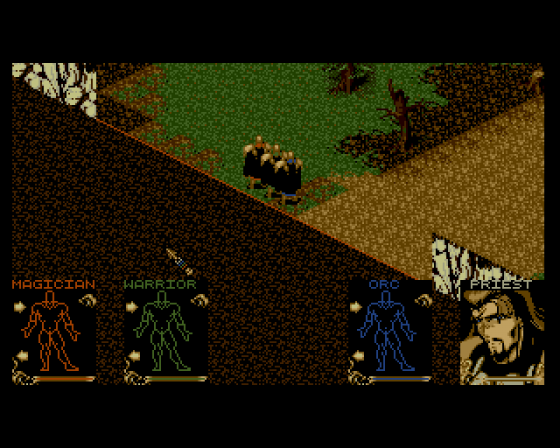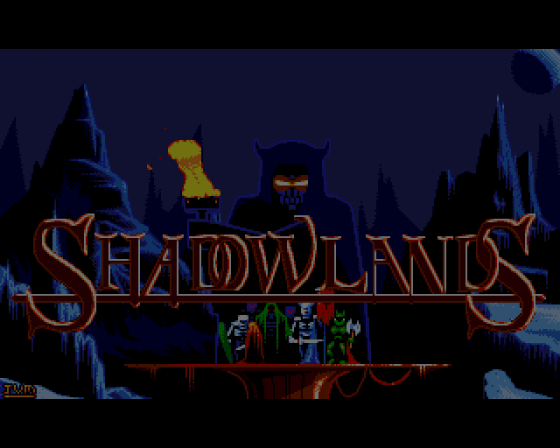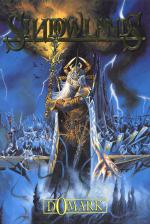
Amiga Power
 1st March 1992
1st March 1992
Categories: Review: Software
Author: Mark Ramshaw
Publisher: Domark
Machine: Amiga 500
Published in Amiga Power #11
Shadowlands
Picking up the reins where Hero Quest left off, Domark come up with a remarkably successful beginner's RPG. And - it's about time someone did it - in its 'Photoscape' light-and-darkness system actually adds something new to the genre.
Nyctophobiacs beware! The powers of light and darkness pervade every nook and cranny of Domark's new fantasy epic. From the way day and night take their turn above ground to the murky depiction of underground passages, Shadowlands is by turns a light-saturated or a visibility-free zone. Torches cast pools of light. Opened doors allow streams of light to fall into adjacent rooms, and the absence of light wreaths everything in uncertainty. It's a Nice Touch alright, but let's be honest - a program which simulated the effects of light and did little else wouldn't be too thrilling. Which is why Shadowlands gives you a 3D isometric, mouse-driven, belts-and-whistles role-playing game into the bargain. (Mmmm, I wonder if I could program my word processor to add the words 'role-playing' into every other review?)
The Mouse Control That Roared
But - hey! - don't stop here arcade fans. It may be one of those fantasy jobbies with nasty demons and undead and all that, but it's far from trainspottery in its execution. Whereas most role-playing games rely on numerous keyboard inputs, references to hit points and seem to display British Rail timetables on the screen for no apparent reason, Shadowlands dispenses with all that sort of guff. Instead, it opts for an entirely mouse-driven control system, one which lets all four characters move together or be given individual instructions and left to do their own things.
Lighter Than Winona's Smile

All movement, object manipulation, eating and fighting is achieved by clicking on the various body parts of the appropriate character in a small box at the bottom of the screen (the on-screen location of these boxes can be altered). To pick an object up is simply a matter of clicking on a character's left hand, then the object in the play area. Throwing the object is similarly achieved by clicking on both hands, then where you want the obejct thrown to. Of course, if it's too heavy, then it's not going to be thrown as far. (And if the distance is negligible, then the character will walk over and carefully drop the object).
There's a lot of clever stuff going on behind the scenes here, all right - object weights, character strengths, distances and even the effects of gravity, all are worked out by the computer as you play. The result is a game that's both realistic and darned intuitive, creating a most believable game world. There are so many of these subtleties in Shadowlands, it's easy to see why it took one and a half years to get it finished.
As you can probably gather from the screenshots, the game is the usual 3D scrolling, isometric romp both above and below ground. Treasures, food, new weapons and spell scrolls can all be collected and used, and there's the inevitable array of monsters and fiendish nasties to be dealt with. And of course, whether it's in combat or character interaction, there's always the light to be taken into consideration. Some monsters are attracted by light, others are repelled by it. There are even traps and puzzles which depend on light. Of course, all this brightness-dependent stuff means that the player's party of characters will need to carry torches everywhere they go - and these have a horrible habit of going out at the most inopportune moments.

This would be bad enough even if the monsters weren't a darn sight smarter than most you'll come across - rest your party in a room without closing the doors first, for instance, and the chances are the sneaky rats that populate the game will be chewing at your warriors' sinews. Yeuck.
Have I mentioned character creation yet? Wow, now that's a doozy section of the program. For a start, there's the appearance of each of the guys or gals in the part. The hair, eyes, nose and mouth/jaw can all be re-defined. In theory, this means that it's possible to create your own image on screen, though in practice things aren't really that flexible - but it's fun to muck around with all the same.
Come On Baby Light My Torch
Then there're the character attributes. In place of boring old numbers, there're nice simple bars representing strength, magik, combat ability and health - you'll find none of those daft references to hit points, constitution, wisdom or dexterity here. If you're not happy with the computer-generated levels of these attributes then the chance card can be used. Doing this will add to some attributes while taking away from others. It's not an exact trade-off, there's a random element to the modifications, so if you want to slightly improve an almost-great character, the chances are you'll end up with a complete wimp. (Them's the breaks.) Having given all four characters a face and a good selection of attributes it's on to the land of shadow itself.

From the short intro bit (some outdoor exploration in the apple orchard and heroes' graveyard) it's into the first dungeon. Here every sort of puzzle is on show in its most basic form - you get to learn the sort of thing you're up against before it all gets much more complex. Don't worry, though - this is one of those clever programs that's sensitive to how well a player is doing, and judges the game accordingly. And, if you're really stuck, there are always the coin-operated help functions. These wall-mounted devices offer not-so-ctyptic help for the totally stumped - but remember that those precious coins may be much better used for buying stuff.
When Push Comes To Shove
The spell system in Shadowlands is another brilliantly simple system. Spell energy can be extracted from active (i.e. energy-laden) objects. A torch or piece of food, for example, is full of potential energy. But sucking an object's lifeforce for casting spells will inevitably make the object less effective. Torches will burn out quicker. Food will have less effect. This idea of trading off one advantage over another is at the heart of Shadowlands. Taking firm control of one area inevitably means losing out in some other way - just like it does in real life in fact.
Back To Gripes, Back To Reality
There's just one problem - I'm running out of space, and I haven't even dug out my list of reviewer's superlatives yet. Before that though, I suppose it'd only be fair to point out a few rough edges - the graphics (too dark and dull) and scrolling being my biggest gripes. And the control system isn't perhaps quite as intuitive as it could be either (that said, half an hour or so should be enough to get the hang of it). These are really fairly minor quibbles though - in gameplay terms the basics are all there, and the size and depth of the whole thing makes me forgive its little faults. I personally find it a lot more refreshing than all the Eye Of The Beholder-lookalike games streaming out right now.
And so into my last paragraph, and I still haven't mentioned the way the walls dissolve into 'architext lines' to give the player a good view of the four characters' movement. I haven't gone into the way that the character formations can be altered at any time. I haven't really mentioned the wonderful sphere of light which follows the players around when they've got a torch, only to gradually diminish as the torch fades. Or the way that the light effects really are ray-traced to make the light fall realistically. Or the way that characters can gang up on monsters, peeling off one at a time to rest and regain health before going back into combat. Or the array of potions and spells to collect. I haven't mentioned the weird and wacky uses of the fireball spell. And I haven't even got space to mention the [Snip! - Ed].
The Bottom Line
Uppers: At last, an RPG game which doesn't inflict statistics on the player. True multi-tasking, brilliantly subtle game mechanics and some finely designed levels and puzzles make Shadowlands a joy, even for the non-RPG types. The use of light and shadows works really well - and actually adds a lot to the game, being integral to much of the puzzle design.
Downers: Despite the presentation and mouse-driven controls,it's never going to compete with arcade games for instant kicks. The graphics are a little rough around the edges, too (the use of colour is pretty unimaginative) and the scrolling is a bit on the crap side. Sound is minimal also - context-sensitive soundtracks would have added a lot to the atmosphere. And it's a pity the shadow effect has to be so blocky.
Shadowlands is to role-playing games what Exile was to arcade games. The hidden rules and physics are integral to everything without being too obvious, contrived or 'visible'. It's not exactly fast, and it's not the best looking thing around, but a quick play will reveal that it's actually damn absorbing stuff. A winner.
Other Reviews Of Shadowlands For The Amiga 500
Shadowlands (Domark)
A review by David Upchurch (Future Publishing)













